fuel consumption TOYOTA MIRAI 2020 Owners Manual (in English)
[x] Cancel search | Manufacturer: TOYOTA, Model Year: 2020, Model line: MIRAI, Model: TOYOTA MIRAI 2020Pages: 528, PDF Size: 11.98 MB
Page 102 of 528
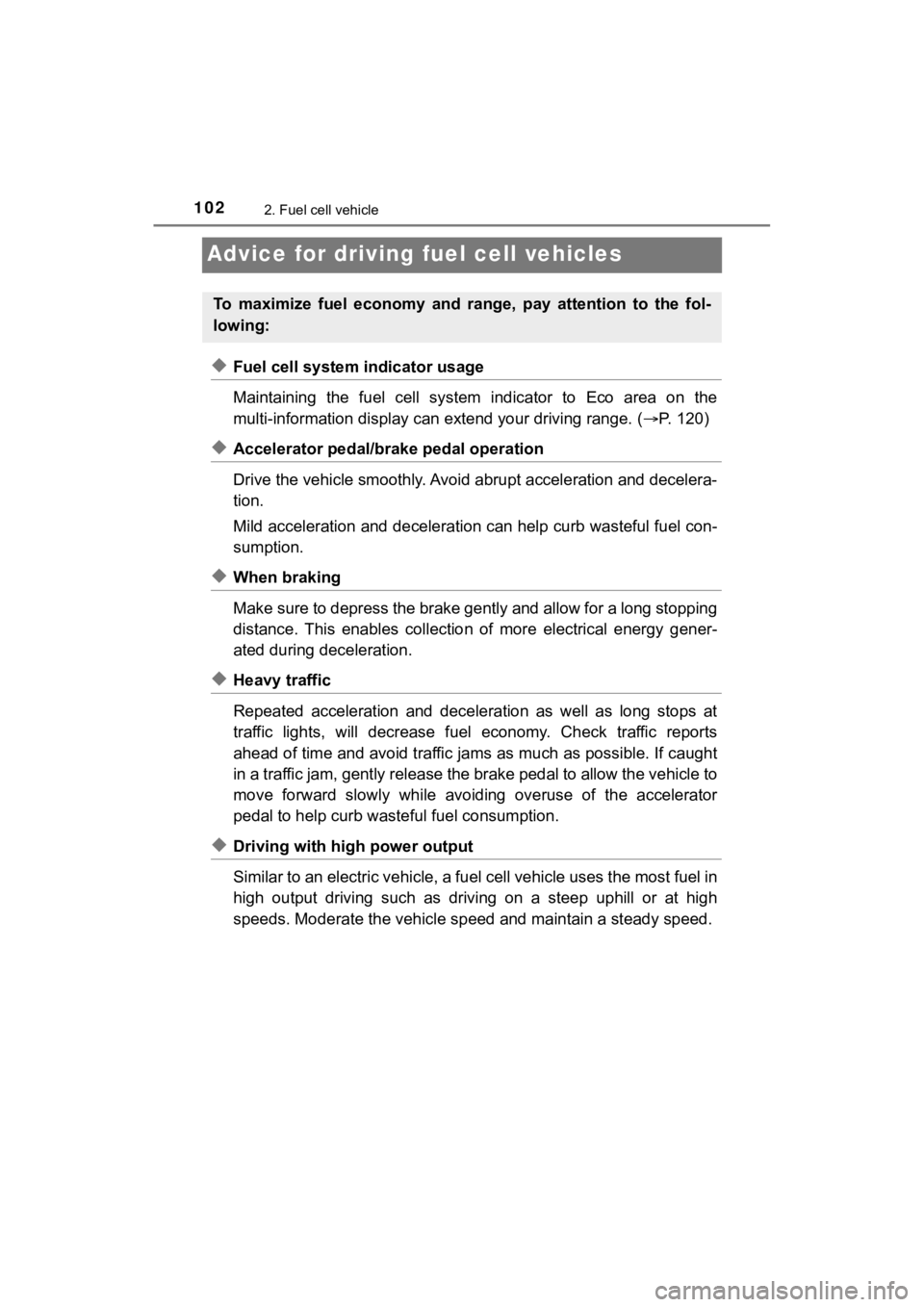
1022. Fuel cell vehicle
MIRAI_OM_USA_OM62073U
Advice for driving fuel cell vehicles
◆Fuel cell system indicator usage
Maintaining the fuel cell system indicator to Eco area on the
multi-information display can extend your driving range. (P. 120)
◆Accelerator pedal/brake pedal operation
Drive the vehicle smoothly. Avo id abrupt acceleration and decel era-
tion.
Mild acceleration and decelerati on can help curb wasteful fuel con-
sumption.
◆When braking
Make sure to depress the brake gently and allow for a long stop ping
distance. This enables collectio n of more electrical energy gen er-
ated during deceleration.
◆Heavy traffic
Repeated acceleration and deceleration as well as long stops at
traffic lights, will decrease fuel economy. Check traffic reports
ahead of time and avoid traffic jams as much as possible. If ca ught
in a traffic jam, gently release the brake pedal to allow the v ehicle to
move forward slowly while avoiding overuse of the accelerator
pedal to help curb wasteful fuel consumption.
◆Driving with high power output
Similar to an electric vehicle, a fuel cell vehicle uses the mo st fuel in
high output driving such as driving on a steep uphill or at hig h
speeds. Moderate the vehicle speed and maintain a steady speed.
To maximize fuel economy and ra nge, pay attention to the fol-
lowing:
Page 103 of 528
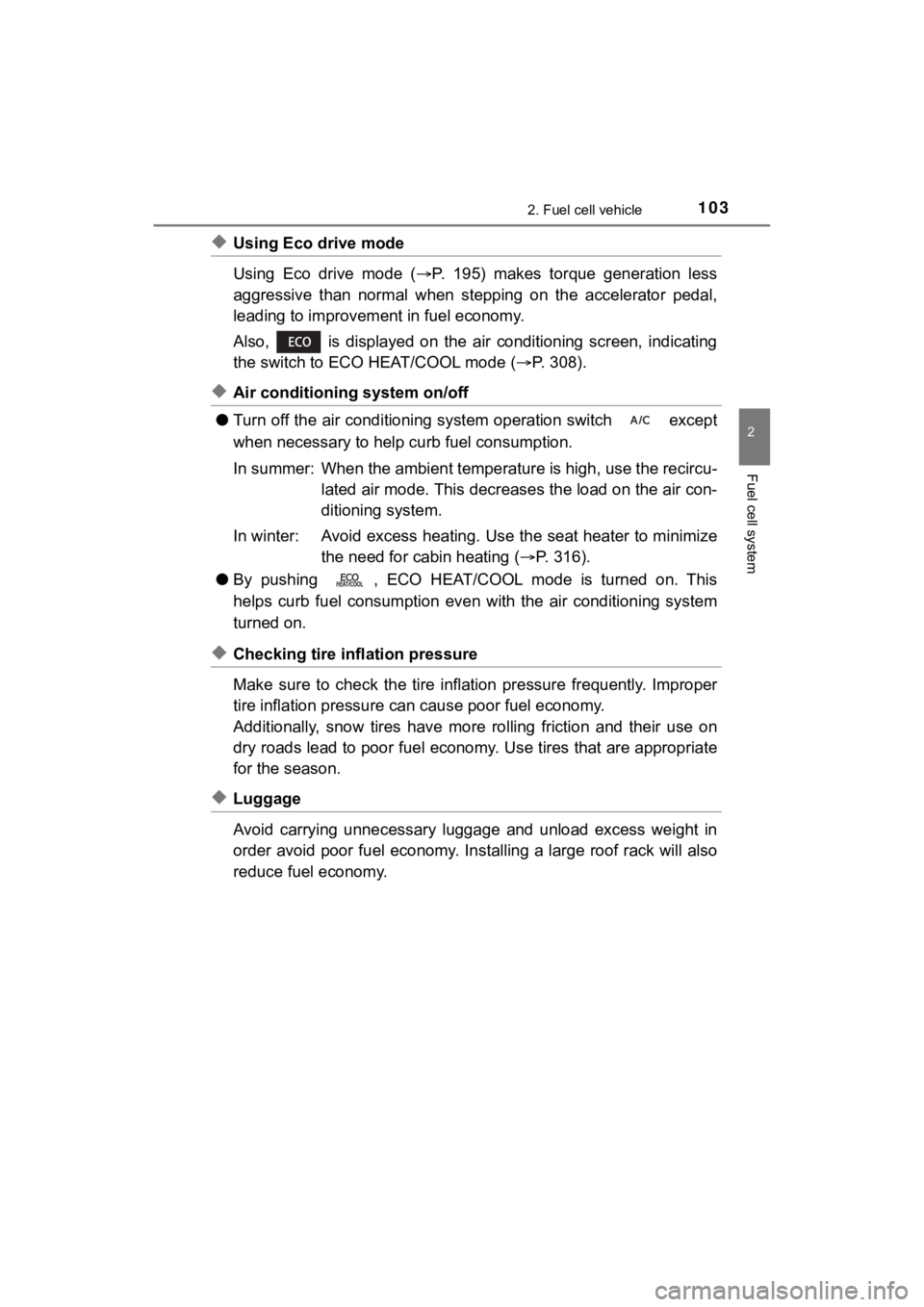
1032. Fuel cell vehicle
2
Fuel cell system
MIRAI_OM_USA_OM62073U
◆Using Eco drive mode
Using Eco drive mode (P. 195) makes torque generation less
aggressive than normal when stepping on the accelerator pedal,
leading to improvement in fuel economy.
Also, is displayed on the air conditioning screen, indicating
the switch to ECO HEAT/COOL mode ( P. 3 0 8 ) .
◆Air conditioning system on/off
● Turn off the air conditioning system operation switch except
when necessary to help curb fuel consumption.
In summer: When the ambient temperature is high, use the recircu -
lated air mode. This decreases the load on the air con-
ditioning system.
In winter: Avoid excess heating. Use the seat heater to minimize the need for cabin heating ( P. 316).
● By pushing , ECO HEAT/COOL mode is turned on. This
helps curb fuel consumption even with the air conditioning syst em
turned on.
◆Checking tire inflation pressure
Make sure to check the tire inflation pressure frequently. Impr oper
tire inflation pressure can cause poor fuel economy.
Additionally, snow tires have mo re rolling friction and their use on
dry roads lead to poor fuel economy. Use tires that are appropr iate
for the season.
◆Luggage
Avoid carrying unnecessary luggage and unload excess weight in
order avoid poor fuel economy. Installing a large roof rack wil l also
reduce fuel economy.
Page 112 of 528

1123. Instrument cluster
MIRAI_OM_USA_OM62073U
Power restriction indicator
Blue: The fuel cell system output power is restricted, because the
coolant temperature is low.
Amber: The fuel cell system output power is restricted, because the
coolant temperature is high.
Outside temperature
Displays the outside temperature within the range of -40°F (-40 °C)
to 122°F (50°C).
Low outside temperature indicator flashes when the ambient tem-
perature is 37°F (3°C) or lower.
Driving range distance
Displays the estimated maximum distance that can be driven with
the quantity of fuel remaining. • Displays the possible driving d istance computed from the fuel
consumption studied f rom the driving history and the current
remaining amount of fuel. The ac tual possible driving distance
may differ as fuel consumpti on changes, depending on driving
environment (weather, traffic, etc.) and conditions (sudden acc el-
eration, air conditioning, etc.).
• When only a small amount of fuel is added to the hydrogen tanks, the display may not be updated.
Speedometer
Displays the vehicle speed.
Odometer and trip meter
Odometer:
Displays the total distance the vehicle has been driven.
Trip meter:
Displays the distance the vehicl e has been driven since the met er
was last reset.
Trip meters “A” and “B” can be used to record and display diffe rent
distances independently.
Distance after start:
Displays the distance driven afte r the fuel cell system was started.
Blank:
A blank is displayed.
Page 114 of 528
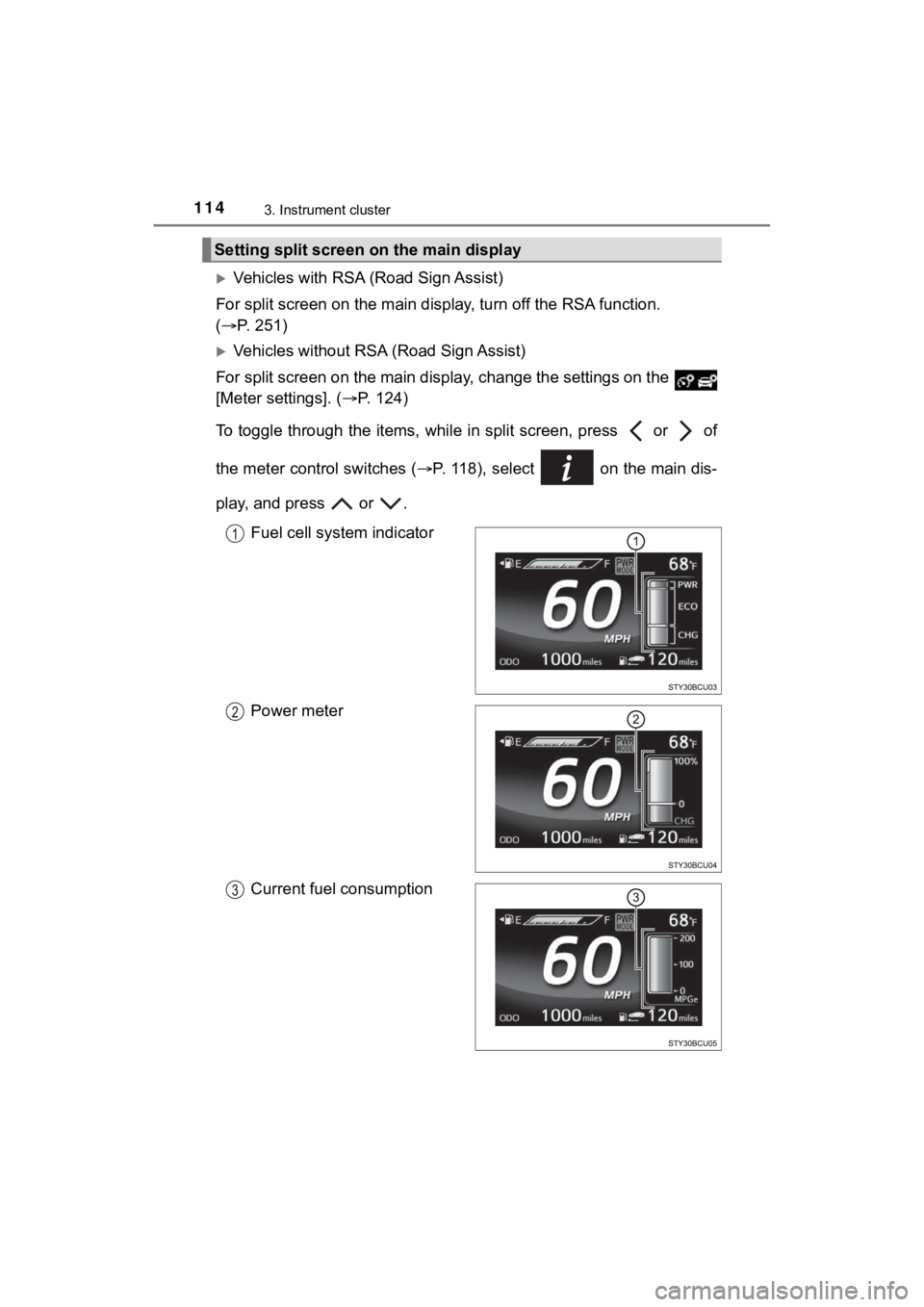
1143. Instrument cluster
MIRAI_OM_USA_OM62073U
Vehicles with RSA (Road Sign Assist)
For split screen on the main dis play, turn off the RSA function.
( P. 251)
Vehicles without RSA (Road Sign Assist)
For split screen on the main display, change the settings on th e
[Meter settings]. ( P. 1 2 4 )
To toggle through the items, while in split screen, press or of
the meter control switches ( P. 118), select on the main dis-
play, and press or . Fuel cell system indicator
Power meter
Current fuel consumption
Setting split screen on the main display
Page 121 of 528
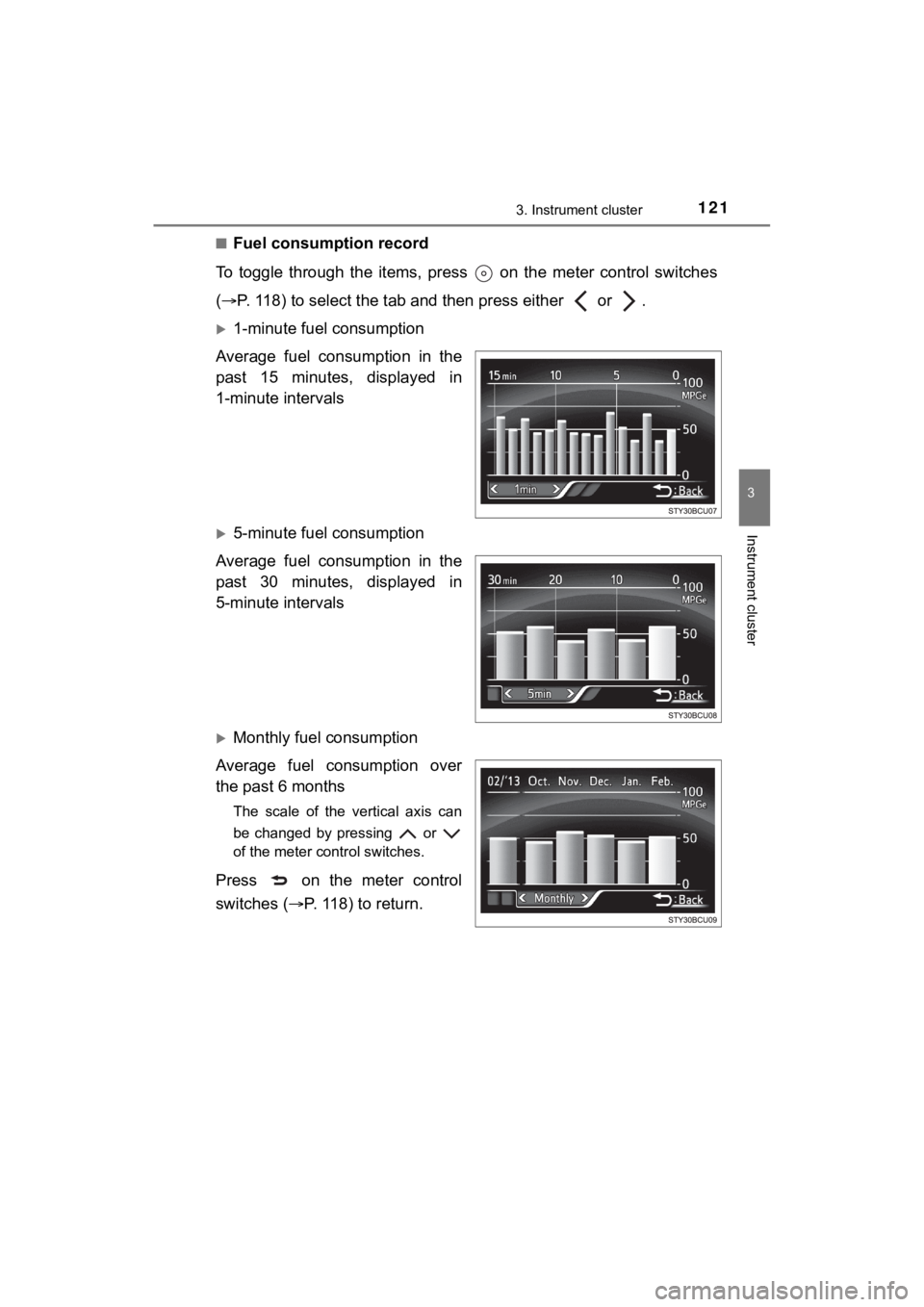
1213. Instrument cluster
3
Instrument cluster
MIRAI_OM_USA_OM62073U■
Fuel consumption record
To toggle through the items, press on the meter control switch es
( P. 118) to select the tab and then press either or .
1-minute fuel consumption
Average fuel consumption in the
past 15 minutes, displayed in
1-minute intervals
5-minute fuel consumption
Average fuel consumption in the
past 30 minutes, displayed in
5-minute intervals
Monthly fuel consumption
Average fuel consumption over
the past 6 months
The scale of the vertical axis can
be changed by pressing or
of the meter control switches.
Press on the meter control
switches ( P. 118) to return.
Page 122 of 528
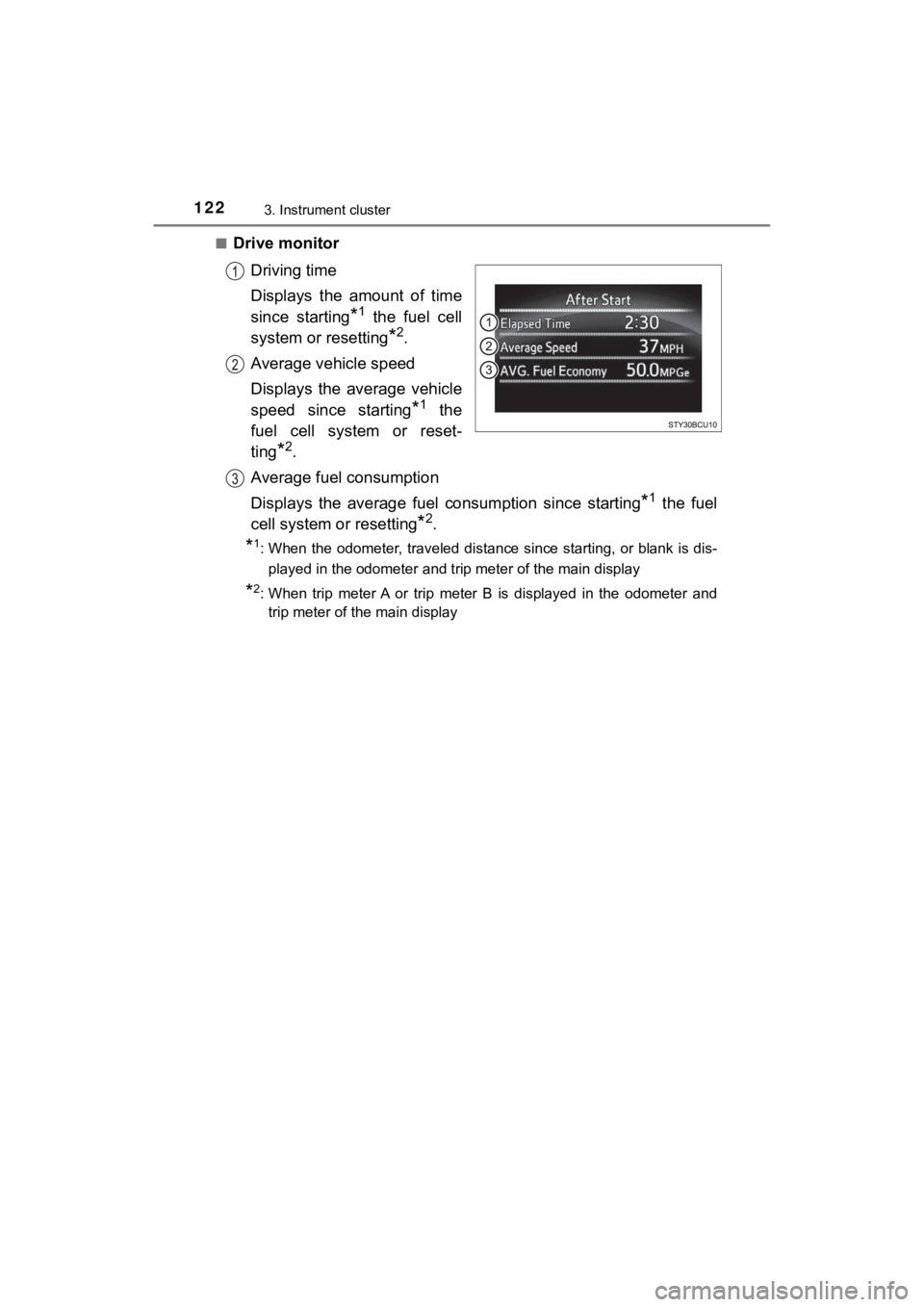
1223. Instrument cluster
MIRAI_OM_USA_OM62073U■
Drive monitor
Driving time
Displays the amount of time
since starting
*1 the fuel cell
system or resetting
*2.
Average vehicle speed
Displays the average vehicle
speed since starting
*1 the
fuel cell system or reset-
ting
*2.
Average fuel consumption
Displays the average fuel consumption since starting
*1 the fuel
cell system or resetting
*2.
*1: When the odometer, traveled distance since starting, or blank is dis-
played in the odometer and trip meter of the main display
*2: When trip meter A or trip meter B is displayed in the odometer and
trip meter of the main display
Page 126 of 528
![TOYOTA MIRAI 2020 Owners Manual (in English) 1263. Instrument cluster
MIRAI_OM_USA_OM62073U
■Setting items
● [Meter settings] items are not selectable while driving and cannot be
operated.
Also, the settings screen is temporarily canceled TOYOTA MIRAI 2020 Owners Manual (in English) 1263. Instrument cluster
MIRAI_OM_USA_OM62073U
■Setting items
● [Meter settings] items are not selectable while driving and cannot be
operated.
Also, the settings screen is temporarily canceled](/img/14/42628/w960_42628-125.png)
1263. Instrument cluster
MIRAI_OM_USA_OM62073U
■Setting items
● [Meter settings] items are not selectable while driving and cannot be
operated.
Also, the settings screen is temporarily canceled in the follow ing situations.
• A warning message is displayed.
• The vehicle starts off.
● Settings for functions not equipped to the vehicle are not disp layed.
● When a function is turned off, the related settings for that fu nction are not
selectable.
■ When the 12-volt battery terminal is disconnected and reconnect ed
The following data is reset when the 12-volt battery terminal i s disconnected
and reconnected.
● 1-minute fuel consumption
● 5-minute fuel consumption
● Driving time
● Average vehicle speed
● Average fuel consumption
■ Liquid crystal display
P. 115
NOTICE
■During setting up the display
To prevent 12-volt battery discharge, ensure that the fuel cell system is
operating while setting up the display features.
Page 308 of 528

3086-1. Using the air conditioning system and defogger
MIRAI_OM_USA_OM62073U
Touch .
The dehumidification function begi ns to operate. Air outlets and fan
speed are automatically adjusted according to the temperature s et-
ting.
Adjust the temperature setting.
Touch .
The cooling and dehumidificati on function switches between on a nd
off each time is touched.
To stop the operation, touch .
■Automatic mode indicator
If the fan speed setting or air flow modes are operated, the au to-
matic mode indicator goes off. However, automatic mode for func -
tions other than that o perated are maintained.
■Switching between outside air and recirculated air modes
Press .
The mode switches between outside air mode (indicator off) and recir-
culated air mode (indicator on) each time is pressed.
■
Using the ECO HEAT/COOL mode
Touch .
is displayed on the air conditioning screen, and the air condi tion-
ing is controlled with low fuel consumption prioritized. When is
touched and held, is displayed on the screen, and the air cond i-
tioning is controlled, even more, with low fuel consumption pri oritized.
(The air conditioning will have more reserved operation.)
When canceling ECO HEAT/COOL mode, touch the again.
may be canceled when other air conditioning operation switches
are touched.
Using the automatic air conditioning system
Other functions
1
2
3
4
Page 311 of 528
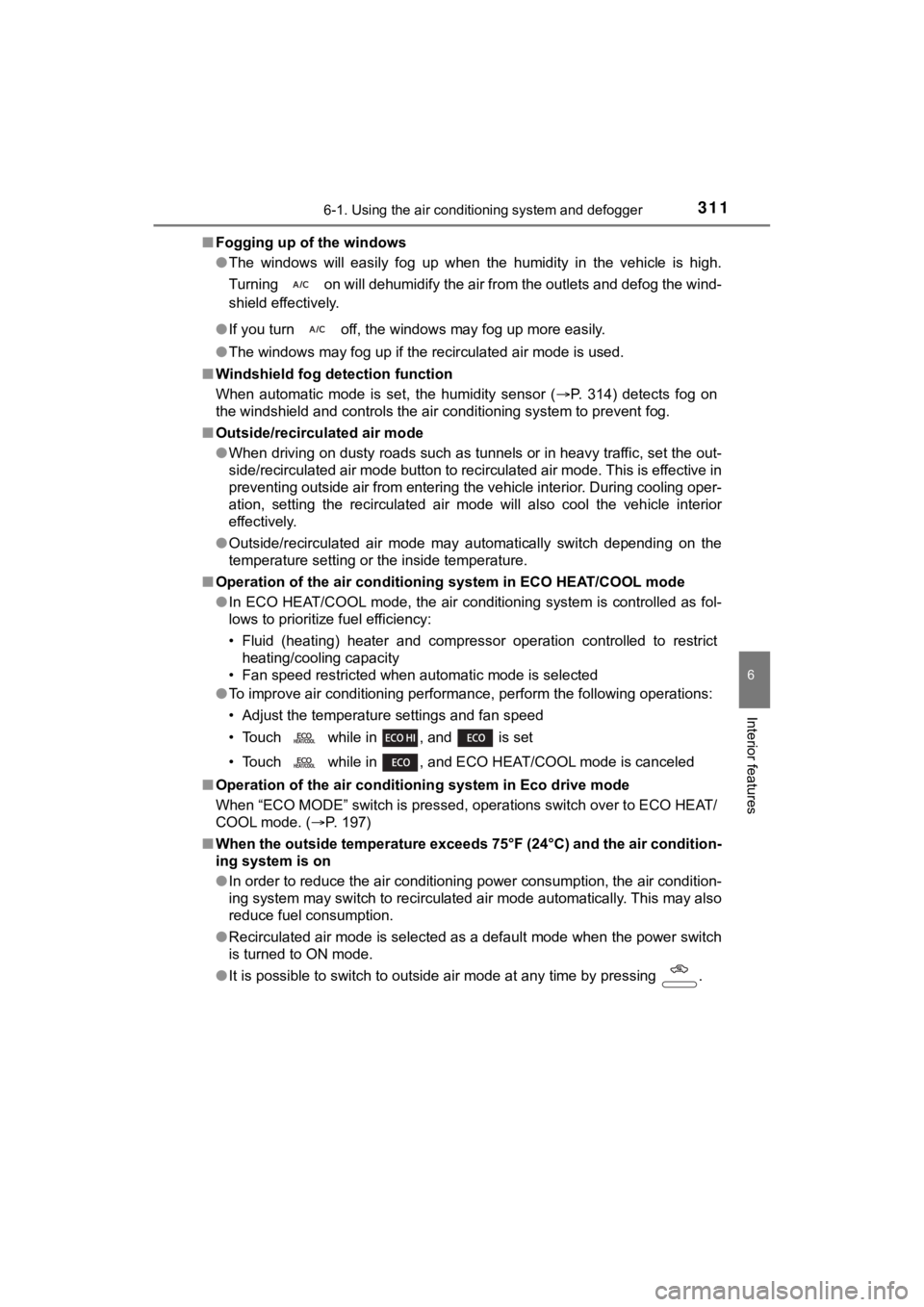
3116-1. Using the air conditioning system and defogger
6
Interior features
MIRAI_OM_USA_OM62073U■
Fogging up of the windows
●The windows will easily fog up when the humidity in the vehicle is high.
Turning on will dehumidify the air from the outlets and defog the wind-
shield effectively.
● If you turn off, the windows may fog up more easily.
● The windows may fog up if the recirculated air mode is used.
■ Windshield fog detection function
When automatic mode is set, the humidity sensor (P. 314) detects fog on
the windshield and controls the air conditioning system to prev ent fog.
■ Outside/recirculated air mode
●When driving on dusty roads such as tunnels or in heavy traffic, set the out-
side/recirculated air mode button to recirculated air mode. Thi s is effective in
preventing outside air from entering the vehicle interior. Duri ng cooling oper-
ation, setting the recirculated air mode will also cool the vehicle interior
effectively.
● Outside/recirculated air mode may automatically switch dependin g on the
temperature setting or the inside temperature.
■ Operation of the air conditioni ng system in ECO HEAT/COOL mode
● In ECO HEAT/COOL mode, the air conditioning system is controlle d as fol-
lows to prioritize fuel efficiency:
• Fluid (heating) heater and compressor operation controlled to restrict
heating/cooling capacity
• Fan speed restricted when automatic mode is selected
● To improve air conditioning performance, perform the following operations:
• Adjust the temperature settings and fan speed
• Touch while in , and is set
• Touch while in , and ECO HEAT/COOL mode is canceled
■ Operation of the air conditioning system in Eco drive mode
When “ECO MODE” switch is pressed, operations switch over to EC O HEAT/
COOL mode. ( P. 197)
■ When the outside temperature exceeds 75°F (24°C) and the air co ndition-
ing system is on
● In order to reduce the air conditioning power consumption, the air condition-
ing system may switch to recirculated air mode automatically. This may also
reduce fuel consumption.
● Recirculated air mode is selected as a default mode when the power switch
is turned to ON mode.
● It is possible to switch to outside air mode at any time by pre ssing .
Page 518 of 528
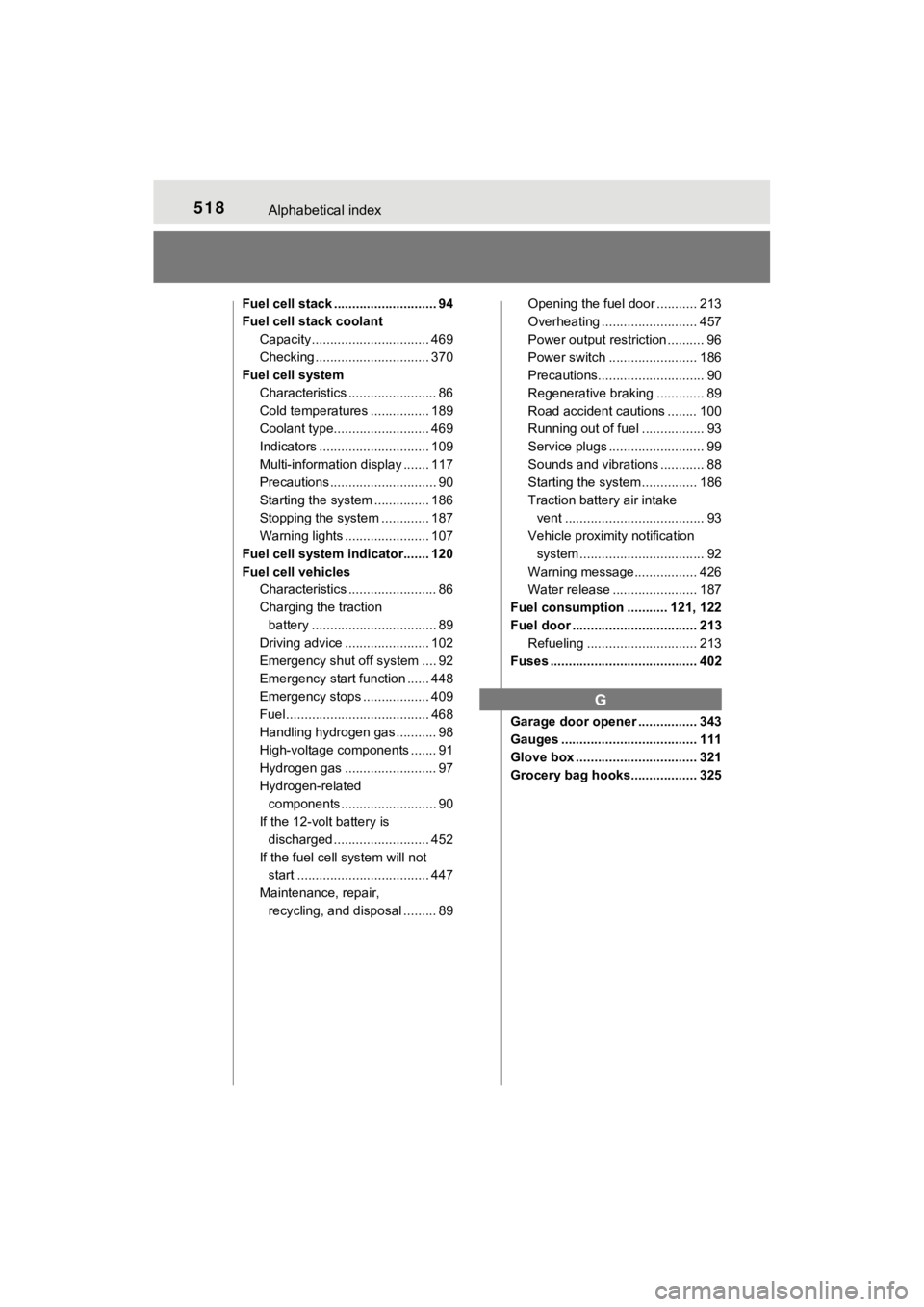
518Alphabetical index
MIRAI_OM_USA_OM62073U
Fuel cell stack ............................ 94
Fuel cell stack coolantCapacity ................................ 469
Checking ............................... 370
Fuel cell system
Characteristics ........................ 86
Cold temperatures ................ 189
Coolant type.......................... 469
Indicators .............................. 109
Multi-information display ....... 117
Precautions ............................. 90
Starting the system ............... 186
Stopping the system ............. 187
Warning lights ....................... 107
Fuel cell system indicator....... 120
Fuel cell vehicles Characteristics ........................ 86
Charging the traction
battery .................................. 89
Driving advice ....................... 102
Emergency shut off system .... 92
Emergency start function ...... 448
Emergency stops .................. 409
Fuel ....................................... 468
Handling hydrogen gas ........... 98
High-voltage components ....... 91
Hydrogen gas ......................... 97
Hydrogen-related
components .......................... 90
If the 12-volt battery is
discharged .......................... 452
If the fuel cell system will not start .................................... 447
Maintenance, repair, recycling, and disposal ......... 89 Opening the fuel door ........... 213
Overheating .......................... 457
Power output restriction .......... 96
Power switch ........................ 186
Precautions............................. 90
Regenerative braking ............. 89
Road accident cautions ........ 100
Running out of fuel ................. 93
Service plugs .......................... 99
Sounds and vibrations ............ 88
Starting the system ............... 186
Traction battery air intake
vent ...................................... 93
Vehicle proximity notification
system .......... ..................... ... 92
Warning message................. 426
Water release ....................... 187
Fuel consumption ........... 121, 122
Fuel door .................................. 213 Refueling .............................. 213
Fuses ........................................ 402
Garage door opener ................ 343
Gauges ..................................... 111
Glove box ................................. 321
Grocery bag hooks.................. 325
G